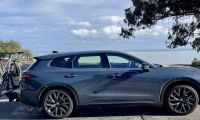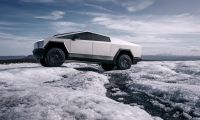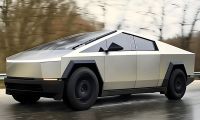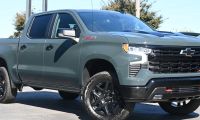May 15th - Following our initial report, CBS News reported that the owner/occupant of the car in this story says the Model S was operating in Autopilot mode and that she was looking at her phone when the crash occurred.
"Did not brake prior to impact." This is starting to become the hallmark of Tesla crashes. In yet another example of $100K supercars slamming into trucks, a Model S has hit the back of a fire department vehicle. This time the crash is in Utah.
If this story sounds familiar, it is because a Tesla Model S slammed into the back of a firetruck on January 22nd. And a Tesla Model S slammed into the side of a truck on May 2, 2016. And a Model X slammed into a highway barrier just last month. Tesla says that all of those accidents involved its Autopilot system. Tesla has not said yet if the latest crash did.
Reports indicate that the Tesla Model S in the latest odd crash did not seem to slow or brake for a red light that the fire department vehicle was stopped at. South Jordan police Sgt. Samuel Winkler said Saturday, “Witnesses indicated the Tesla Model S did not brake prior to impact."
Tesla's autopilot is described by Tesla as a beta system. The term is derived from the term used to describe the second prototype of a given technical device. Why Tesla is allowed to operate a system that is not fully tested is unclear.
Tesla Model S Quick Facts:
The Model S is one of the few top-selling electric vehicles not to have earned the IIHS Top Safety Pick designation. Priced from roughly the high $70Ks to the mid $100Ks, the fastest version of the Model S can accelerate from 0-60 MPH in about 2.5 seconds. All-electric, the Model S was the first long-range battery electric vehicle on the market in the U.S.
Still image courtesy of Youtube and mobnews.













Comments
I will not be surprised if
Permalink
I will not be surprised if Tesla has to install a camera inside the car to make sure people are keeping their eyes on the road. Honestly I don't get why anyone would use a feature like this without knowing its limits. I love AP but I also know its limits and am prepared to take control.
A story in The Verge & WSJ
Permalink
In reply to I will not be surprised if by John (not verified)
A story in The Verge & WSJ says that Tesla knew the system required such a device, considered it, contacted vendors, and then abandoned the idea. You can cut and paste this link to read more in that publication. https://www.theverge.com/2018/5/14/17352814/elon-musk-tesla-autopilot-face-tracking-gm
1. Autopilot does not mean
Permalink
1. Autopilot does not mean what you think it means
2. It was raining. Autopilot is not to be used when raining/snowing
3. Driver was on a surface street rather than an expressway. Tesla specifically states not to use on surface streets.
4. This driver walked away with a broken ankle... that is all. The car kept the passenger alive and well despite being completely reckless.
Did you mean to be funny, or
Permalink
In reply to 1. Autopilot does not mean by Martha (not verified)
Did you mean to be funny, or were you serious when you made this post, Martha? It's hard to tell sometimes.
Is this is a surface street? (you will have to cut and paste) https://www.tesla.com/videos/autopilot-self-driving-hardware-neighborhood-long
Here is a quote from Tesla's official description of Autopilot "A forward-facing radar with enhanced processing provides additional data about the world on a redundant wavelength that is able to see through heavy rain, fog, dust and even the car ahead." https://www.tesla.com/autopilot
John the video you posted
Permalink
In reply to Did you mean to be funny, or by John Goreham
John the video you posted above is of the full autonomous that isn't available yet. You might want to do some research on what you are writing about.
Thank you Chris. We do try to
Permalink
In reply to John the video you posted by Chris (not verified)
Thank you Chris. We do try to stay current. Here is an interesting story from Elektrek title "Tesla enables Autosteer on ‘local roads’ for new Enhanced Autopilot vehicles"
"https://electrek.co/2017/02/15/tesla-autopilot-autosteer-local-roads-enhanced-autopilot/
Might also be better to ask
Permalink
Might also be better to ask how many lives were saved that day by autopilot as it has been shown to protect lives better per mile driven than human pilots.
According to IIHS and HDLI,
Permalink
In reply to Might also be better to ask by Chris (not verified)
According to IIHS and HDLI, Tesla's Model S has a higher rate of crashes than other large vehicles and also a higher rate of crashes than other EVs. Link is here. You will need to cut and paste: http://www.iihs.org/iihs/sr/statusreport/article/52/4/4 Here is the crux of the study's findings: "In comparison, the Model S had higher claim frequencies, higher claim severities and higher overall losses than other large luxury cars. Under collision coverage, for example, analysts estimated that the Model S's mileage-adjusted claim frequency was 37 percent higher than the comparison group, claim severity was 64 percent higher, and overall losses were 124 percent higher."